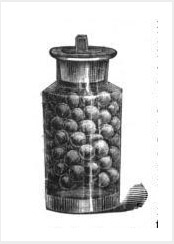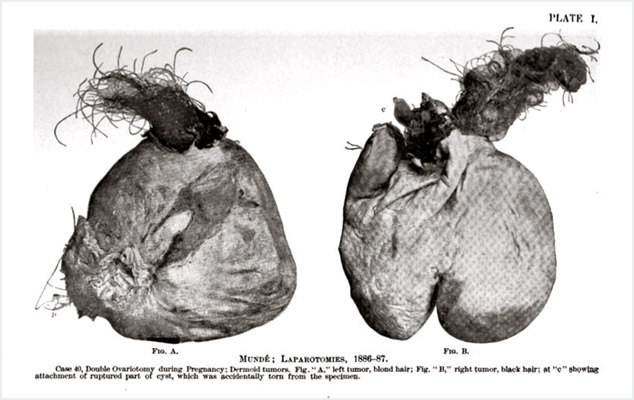
Journal : American Journal of Obstetrics ; vol. xxi.
New York : William Wood, 1888.
Description : 15-40 p., [4 l. pl.], 136-155 ; ill.: 4 photo. leafs, 2 figs., tbls. ; 23 cm.
Photographs : photoengravings of specimens.
Photographer : O. G. Mason.
Subject : Ovaries — Teratomas ; Ovariotomy.
Notes :

On March 30th I performed ovariotomy, removing a dermoid cyst of the right ovary, weighing twelve pounds, and containing numerous smooth, yellow balls of the size of hazel-nuts, floating in a pea-soup-colored fluid. These balls were examined by Professor Welch, of Johns Hopkins University, Baltimore, who pronounced them a great rarity, there being only two other cases on record —one by Rokitansky, Sr., the other by Routh, of London. Since then Christian Fenger, of Chicago, has reported a similar case from his own practice. Professor Welch states that the balls are composed of sebaceous matter, each ball containing one hair. The manner of their formation and of their acquiring so uniform and regular a shape, as by attrition, is a mystery.

After graduating Harvard medical school in 1866, Dr. Mundé served in the Bavarian army during the seven-week Austro-Prussian war. He then schooled in obstetrics at Vienna, earning his Master of Obstetrics in 1871 when the outbreak of the Franco-Prussian war drew him back into the army as battalion surgeon to the Second Corps. For his heroic rescue of wounded soldiers from a burning German field hospital, he was bestowed the Iron Cross. After the war, Mundé toured the hospitals of Europe for a year and returned to America in 1872. He chronicled his European experience in a book titled, A glimpse of laparotomy in Europe, published in 1886.
For his report on a year of laparotomies, Mundé was motivated to write because of the unusual number of anomalous cases he encountered during 1886. Especially interesting are the descriptions of dermoid cysts occurring in the ovaries. Rarest of these was a large "floating ball" cystic teratoma containing sebum nodes, each embedded with a single hair (Case 37). A woodcut is provided of the bottled specimen. The most difficult case in the Mundé report, illustrated by Plate I, was the excision of two dermoid cysts from a woman, six months pregnant. Fig. B represents the adherent ovarian cyst, filled with black hair and Fig A represents the nonadherent multilocular tumor proximal to the gravid uterus, already ruptured and filled with blond hair (Case 40). Both cases and their illustrations were reproduced in the 1891 sixth edition of Dr. Theodore Gaillard Thomas's, A Practical Treatise on the Diseases of Women, revised and enlarged by Mundé.
